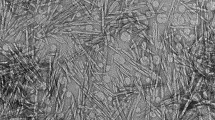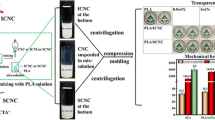Abstract
Cellulose-derived materials are usually characterized by sophisticated structures, leading to unique and multiple functions, which have been a source of inspiration for the fabrication of a wide variety of nanocomposites. Cellulose nanocrystals/poly(acrylamide) (CNCs/PAM) nanocomposite hydrogels were synthesized via in situ polymerization in the CNC suspension. The cellulose from pulp fiber under different sulfuric acid hydrolysis conditions, examined by conductometric titration and transmission electron microscopy, was applied to study how the effects of the surface charge and aspect ratio affect CNCs’ mechanical reinforcement in nanocomposites. The results indicated that the higher surface charge concentration resulted in better dispersibility in aqueous suspension, leading to a more efficient energy dissipation process. The CNC reinforcement behavior followed the percolation model where the greater aspect ratio of CNC contributed to higher mechanical properties. The preferential adsorption of poly(ethylene glycol) (PEG) on the CNC surface was characterized by zeta potential measurements where the fracture strength and fracture elongation of nanocomposites decreased with increasing PEG concentration. The adsorption of PEG on the CNC surface occupied the active sites for polymer chain propagation, which hindered the PAM cross-linking effect on the CNC surface and decreased the cross-linking density of the network.









Similar content being viewed by others
References
Abbott A, Bismarck A (2010) Self-reinforced cellulose nanocomposites. Cellulose 17:779–791
Angelikopoulos P, Harthy SA, Bock H (2009) Structural forces from directed self-assembly. J Phys Chem B 113:13817–13824
Appel EA, del Barrio J, Loh XJ, Scherman OA (2012) Supramolecular polymeric hydrogels. Chem Soc Rev 41:6195–6214
Araki J, Wada M, Kuga S (2001) Steric stabilization of a cellulose microcrystal suspension by poly(ethylene glycol) grafting. Langmuir 17:21–27
Capadona JR, Shanmuganathan K, Trittschuh S, Seidel S, Rowan SJ, Weder C (2009) Polymer nanocomposites with nanowhiskers isolated from microcrystalline cellulose. Biomacromolecules 10:712–716
De Greef TFA, Smulders MMJ, Wolffs M, Schenning APHJ, Sijbesma RP, Meijer EW (2009) Supramolecular polymerization. Chem Rev 109:5687–5754
Dong XM, Revol JF, Gray DG (1998) Effect of microcrystallite preparation conditions on the formation of colloid crystals of cellulose. Cellulose 5:19–32
Du Y, Shen SZ, Cai KF, Casey PS (2012) Research progress on polymer–inorganic thermoelectric nanocomposite materials. Prog Polym Sci 37:820–841
Eichhorn SJ (2011) Cellulose nanowhiskers: promising materials for advanced applications. Soft Matter 7:303–315
Elsabahy M, Wooley K (2012) Design of polymeric nanoparticles for biomedical delivery applications. Chem Soc Rev 41:2545–2561
Favier V, Chanzy H, CavailléJ Y (1996) Polymer nanocomposites reinforced by cellulose whiskers. Macromolecules 28:6365–6367
Flory PJ (1953) Principles of polymer chemistry. Cornell University, Ithaca
Fox J, Wie JJ, Greenland BW, Burattini S, Hayes W, Colquhoun HM, Mackay ME, Rowan SJ (2012) High-strength, healable, supramolecular polymer nanocomposites. J Am Chem Soc 134:5362–5368
Garbin V, Crocker JC, Stebe KJ (2012) Nanoparticles at fluid interfaces: exploiting capping ligands to control adsorption, stability and dynamics. J Colloid Interface Sci 387:1–11
Gersappe D (2002) Molecular mechanisms of Failure in polymer nanocomposites. Phys Rev Lett 89:058301
Goffin AL, Raquez JM, Duquesne E, Siqueira G, Habibi Y, Dufresne A, Dubois P (2011) From interfacial ring-opening polymerization to melt processing of cellulose nanowhisker-filled polylactide-based nanocomposites. Biomacromolecules 12:2456–2465
Habibi Y, Lucia LA, Rojas OJ (2010) Cellulose nanocrystals: chemistry, self-assembly, and applications. Chem Rev 110:3479–3500
Joshi RK, Schneider JJ (2012) Assembly of one dimensional inorganic nanostructures into functional 2D and 3D architectures. Synthesis, arrangement and functionality. Chem Soc Rev 41:5285–5312
Kao J, Thorkelsson K, Bai P, Rancatore BJ, Xu T (2013) Toward functional nanocomposites: taking the best of nanoparticles, polymers, and small molecules. Chem Soc Rev 42:2654–2678
Langner KM, Sevink GJA (2012) Mesoscale modeling of block copolymer nanocomposites. Soft Matter 8:5102–5118
Levy I, Shoseyov O (2002) Cellulose-binding domains: biotechnological applications. Biotechnol Adv 20:191–213
Lin N, Huang J, Dufresne A (2012) Preparation, properties and applications of polysaccharide nanocrystals in advanced functional nanomaterials: a review. Nanoscale 4:3274–3294
Loizou E, Butler P, Porcar L, Kesselman E, Talmon Y, Dundigalla A, Schmidt G (2005) Large scale structures in nanocomposite hydrogels. Macromolecules 38:2047–2049
Lu ZD, Yin YD (2012) Colloidal nanoparticle clusters: functional materials by design. Chem Soc Rev 41:6874–6887
Moon RJ, Martini A, Nairn J, Simonsen J, Youngblood J (2011) Cellulose nanomaterials review: structure, properties and nanocomposites. Chem Soc Rev 40:3941–3994
Roy D, Semsarilar M, Guthrie JT, Perrier S (2009) Cellulose modification by polymer grafting: a review. Chem Soc Rev 38:2046–2064
Rubinstein M, Colby RH (2003) Polymer physics. Oxford University Press, Oxford
Rusli R, Shanmuganathan K, Rowan SJ, Weder C, Eichhorn SJ (2011) Stress transfer in cellulose nanowhisker composites—influence of whisker aspect ratio and surface charge. Biomacromolecules 12:1363–1369
Seiffert S, Sprakel J (2012) Physical chemistry of supramolecular polymer networks. Chem Soc Rev 41:909–930
Siró I, Plackett D (2010) Microfibrillated cellulose and new nanocomposite materials: a review. Cellulose 17:459–494
Spagnol C, Rodrigues FHA, Pereira AGB, Fajardo AR, Rubira AF, Muniz EC (2012) Superabsorbent hydrogel nanocomposites based on starch-g-poly(sodium acrylate) matrix filled with cellulose nanowhiskers. Cellulose 19:1225–1237
Treloar LRG (2005) The physics of rubbery elasticity. Clarendon Press, London
Vesaratchanon S, Nikolov A, Wasan DT (2007) Sedimentation in nano-colloidal dispersions: effects of collective interactions and particle charge. Adv Colloid Interface 134:268–278
Yang J, Han CR, Duan JF, Ma MG, Zhang XM, Xu F, Sun RC (2013) Synthesis and characterization of mechanically flexible and tough cellulose nanocrystals–polyacrylamide nanocomposite hydrogels. Cellulose 20:227–237
Zhang H, Liu Y, Yao D, Yang B (2012) Hybridization of inorganic nanoparticles and polymers to create regular and reversible self-assembly architectures. Chem Soc Rev 41:6066–6088
Acknowledgments
This work was financially supported by the Fundamental Research Funds for the Central Universities (TD2011-10), Beijing Forestry University Young Scientist Fund (BLX2011010) and the Research Fund for the Doctoral Program of Higher Education of China (20120014120006). Open fund of Key laboratory of Chemistry and Engineering of forest Products of Guangxi (GXFC11-4).
Author information
Authors and Affiliations
Corresponding author
Electronic supplementary material
Below is the link to the electronic supplementary material.
Rights and permissions
About this article
Cite this article
Yang, J., Zhao, JJ., Han, CR. et al. Tough nanocomposite hydrogels from cellulose nanocrystals/poly(acrylamide) clusters: influence of the charge density, aspect ratio and surface coating with PEG. Cellulose 21, 541–551 (2014). https://doi.org/10.1007/s10570-013-0111-4
Received:
Accepted:
Published:
Issue Date:
DOI: https://doi.org/10.1007/s10570-013-0111-4




